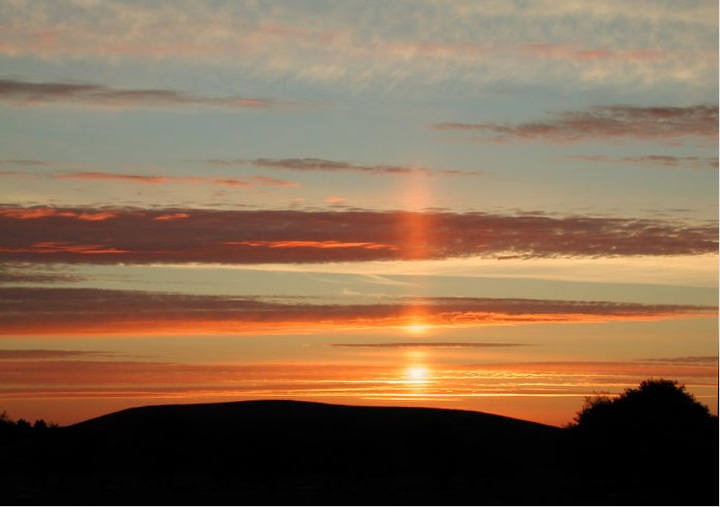Sun pillar, Powys Wales
Sun Pillar: A Captivating Atmospheric Phenomenon in Powys, Wales
Have you ever witnessed a breathtaking display of light and wonder in the sky? If you happen to be in Powys, Wales on a crisp autumn morning, you might just be lucky enough to witness a captivating atmospheric phenomenon known as a sun pillar. This awe-inspiring sight occurs when sunlight interacts with ice crystals in the atmosphere, creating a pillar of light that appears to extend vertically above or below the sun. Let's delve into the enchanting world of sun pillars and explore the mesmerizing details of a sun pillar observed in Powys, Wales.
The Splendor of an Autumnal Dawn
On the morning of October 6th, 2000, Ian Collins captured a remarkable photograph of a sun pillar during an autumnal dawn in Powys, Wales. The image portrays a picturesque landscape where the just-risen sun is still concealed behind the hills, casting a warm glow on the surroundings. The sun pillar itself is fragmented into several bright patches, each indicating the location of ice crystals that contribute to its formation. This photograph serves as a testament to the stunning beauty that can be found in the natural world.
Unraveling the Science Behind Sun Pillars
To truly appreciate the magnificence of a sun pillar, it's essential to understand the science behind this atmospheric phenomenon. Sun pillars are a type of optical phenomenon known as a halo. Halos occur when light is refracted or bent by ice crystals suspended in the atmosphere. In the case of a sun pillar, the ice crystals responsible for its formation are typically plate-shaped or column-shaped. As sunlight passes through these crystals, it becomes horizontally polarized and is subsequently scattered in a vertical direction, resulting in the appearance of a radiant pillar of light.
Ice Crystals: The Architects of Sun Pillars
The presence of specific types of ice crystals in the atmosphere is crucial for the formation of a sun pillar. These crystals, often referred to as pillar-forming ice crystals, play a vital role in shaping the appearance of the pillar. In Powys, Wales, the bright patches within the sun pillar photographed by Ian Collins indicate the precise locations where these ice crystals are located. By studying these patches, scientists can gain valuable insights into the nature and behavior of ice crystals in different atmospheric conditions.
Atmospheric Conditions: Setting the Stage for Sun Pillars
Various atmospheric conditions contribute to the occurrence of sun pillars. One essential factor is the presence of high-altitude cirrus clouds, which are composed of ice crystals. These clouds act as a canvas upon which the sun's light interacts with the ice crystals, creating the mesmerizing display of a sun pillar. Additionally, the orientation and alignment of the ice crystals play a significant role in determining the shape and size of the pillar. Factors such as temperature, humidity, and wind patterns can all influence the formation and appearance of sun pillars.
The Ethereal Beauty of Powys, Wales
Powys, Wales, with its diverse landscapes and captivating natural beauty, provides an ideal backdrop for witnessing atmospheric phenomena like sun pillars. Nestled amidst rolling hills and picturesque countryside, Powys offers a serene and tranquil setting for observers to marvel at the wonders of the sky. The combination of the region's unique geographical features and its favorable atmospheric conditions makes it an enchanting location for experiencing the ethereal beauty of a sun pillar.
A Glimpse into Nature's Artistry
Sun pillars are not only a testament to the scientific principles governing our atmosphere but also a stunning example of nature's artistry. These radiant pillars of light serve as a reminder of the intricate interplay between light, ice crystals, and atmospheric conditions. As we gaze upon a sun pillar in Powys, Wales, we are reminded of the vastness and complexity of our natural world. Each shimmering patch within the pillar tells a story of the countless ice crystals suspended in the air, coming together to create a spectacle that leaves us in awe.
In conclusion, the sun pillar captured by Ian Collins in Powys, Wales, offers a glimpse into the captivating world of atmospheric optics. This natural phenomenon, born from the interaction of sunlight with ice crystals in the atmosphere, showcases the intricate beauty and scientific principles at play in our environment. Whether you're a scientist studying the behavior of ice crystals or an admirer of nature's wonders, a sun pillar is an enchanting sight that reminds us of the boundless marvels that surround us. So, next time you find yourself in Powys, Wales, keep your eyes to the sky, for you may just witness the breathtaking dance of a sun pillar.

Autumnal dawn with sun pillar, Powys, Wales. Captured by Ian Collins on 6th October 2000 while the just risen sun was still hidden by the hills. The pillar is fragmented into a number of bright patches which indicate the locations of pillar forming ice crystals. ©Ian Collins, reproduced with permission.
Note: this article has been automatically converted from the old site and may not appear as intended. You can find the original article here.
Reference Atmospheric Optics
If you use any of the definitions, information, or data presented on Atmospheric Optics, please copy the link or reference below to properly credit us as the reference source. Thank you!
-
<a href="https://atoptics.co.uk/blog/sun-pillar-powys-wales/">Sun pillar, Powys Wales</a>
-
"Sun pillar, Powys Wales". Atmospheric Optics. Accessed on November 26, 2024. https://atoptics.co.uk/blog/sun-pillar-powys-wales/.
-
"Sun pillar, Powys Wales". Atmospheric Optics, https://atoptics.co.uk/blog/sun-pillar-powys-wales/. Accessed 26 November, 2024
-
Sun pillar, Powys Wales. Atmospheric Optics. Retrieved from https://atoptics.co.uk/blog/sun-pillar-powys-wales/.